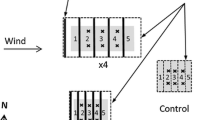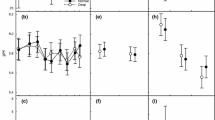Abstract
Climate warming in The Arctic may lead to a shift from graminoid to shrub dominance, which may, in turn, alter the structure and function of the ecosystem through shrub influences on the abiotic and/or biotic controls over biogeochemical cycles of carbon (C) and nitrogen (N). In Arctic tundra, near Toolik Lake, Alaska, we quantified net N-mineralization rates under ambient and manipulated snow treatments at three different plant communities that varied in abundance of deciduous shrubs. Our objective was twofold: (1) to test whether the amount of snow that can accumulate around Arctic deciduous shrubs maintains winter soil temperatures high enough to stimulate microbial activity and increase soil N levels (effect of soil microclimate) and (2) to compare the relative effects of snow versus shrubs on N availability via effects on the main drivers of N-mineralization: SOM quality versus microclimate. Winter snow addition had a positive effect on summer, but not winter, N-mineralization rates. Soil organic matter quality had a nine times larger effect on N-mineralization than did soil microclimate in the summer season and only SOM quality had a detectable effect on N-mineralization in the winter. Here we conclude that on a short time scale, shrub interactions with snow may play a role in increasing plant available N, primarily through effects on the summer soil microenvironment. In addition, differences in SOM quality can drive larger differences in net N-mineralization than changes in soil microclimate of the magnitude of what we saw across our three sites.



Similar content being viewed by others
References
ACIA. 2004. Impacts of a warming arctic: Arctic Climate Impact Assessment.
Borner AP, Kielland K, Walker M. 2008. Effects of simulated climate change on plant phenology and nitrogen mineralization in Alaskan Arctic Tundra. Arct Antarct Alp Res 40:27–38.
Bret-Harte MS, Shaver GR, Zoerner JP, Johnstone JF, Wagner JL, Chavez AS, Gunkelman RF, Lippert SC, Laundre JA. 2001. Developmental plasticity allows Betula nana to dominate tundra subjected to an altered environment. Ecology 82:18–32.
Bret-Harte MS, Mack MC, Goldsmith GR, Sloan DB, DeMarco J, Shaver GR, Ray PM, Biesinger Z, Chapin FSIII. 2008. Plant functional types do not predict biomass responses to removal and fertilization in Alaskan tussock tundra. J Ecol 96:713–26.
Brooks PD, Williams MW, Schmidt SK. 1996. Microbial activity under snow packs, Niwot Ridge, Colorado. Biogeochemistry 32:93–113.
Brooks PD, Williams MW, Schmidt SK. 1998. Inorganic nitrogen and microbial biomass dynamics before and during spring snowmelt. Biogeochemistry 43:1–15.
Buckeridge KM, Grogan P. 2008. Deepened snow alters soil microbial nutrient limitations in arctic birch hummock tundra. Appl Soil Ecol 39:210–22.
Buckeridge KM, Zufelt E, Chu H, Grogan P. 2010. Soil nitrogen cycling rates in low arctic shrub tundra are enhanced by litter feedbacks. Plant Soil 330:407–21.
Burke IC. 1989. Control of nitrogen mineralization in a sagebrush steppe landscape. Ecology 70:1115–26.
Chapin FSIII, Shaver GR. 1996. Physiological and growth responses of arctic plants to a field experiment simulating climate change. Ecology 77:822–40.
Chapin FSIII, Fetcher N, Keilland K, Everett KR, Linkins AE. 1988. Productivity and nutrient cycling of Alaskan tundra: enhancement by flowing soil water. Ecology 69:693–702.
Chapin FSIII, Shaver GR, Giblin AE, Nadelhoffer KJ, Laundre JA. 1995. Responses of Arctic tundra to experimental and observed changes in climate. Ecology 76:694–711.
Chen J, Stark JM. 2000. Plant species effects and carbon and nitrogen cycling in a sagebrush-crested wheatgrass soil. Soil Biol Biochem 32:47–57.
Clemmensen KE, Michelsen A, Jonasson S, Shaver GR. 2006. Increased ectomycorrhizal fungal abundance after long-term fertilization and warming of two arctic tundra ecosystems. New Phytol 171:391–404.
Coxson DS, Parkins D. 1987. Winter respiratory activity in an aspen woodland forest floor litter and soils. Soil Biol Biochem 19:49–59.
DiStefano JF, Gholz HL. 1986. A proposed use of ion exchange resins to measure nitrogen mineralization and nitrification in intact soil cores. Commun Soil Sci Plant Anal 17:989–98.
Flanagan PW, Van Cleve K. 1983. Nutrient cycling in relation to decomposition and organic-matter quality in taiga ecosystems. Can J For Res 13:795–817.
Giblin AE, Nadelhoffer KJ, Shaver GR, Laundre JA, McKerrow AJ. 1991. Biogeochemical diversity along a riverside toposequence in Arctic Alaska. Ecol Monogr 61:415–35.
Grogan P, Jonasson S. 2003. Controls on annul nitrogen cycling in the understory of a subarctic birch forest. Ecology 84:202–18.
Hamilton TD. 1986. Late Cenozoic glaciation of the central Brooks Range. In: Hamilton TD, Reed KM, Thorson RM, Eds. Glaciation in Alaska—the geological record. Anchorage: Alaska Geological Society. p 9–49.
Hart SC, Firestone MK. 1989. Evaluation of three in situ soil nitrogen availability assays. Can J For Res 19:185–91.
Hobbie SE. 1992. Effects of plant species on nutrient cycling. Trends Ecol Evol 7:336–9.
Hobbie SE. 1996. Temperature and plant species control over litter decomposition in Alaskan tundra. Ecol Monogr 66:503–22.
Jenny H. 1994. Factors of soil formation a system of quantitative pedology. New York: Dover Publications, Inc.
Mack MC, D’Antonio CM. 2003. Exotic grasses alter controls over soil nitrogen dynamics in a Hawaiian woodland. Ecol Appl 13:154–66.
Mack MC, Schuur EAG, Bret-Harte MS, Shaver GR, Chapin FSIII. 2004. Ecosystem carbon storage in arctic tundra reduced by long-term nutrient fertilization. Nature 431:440–3.
Matson PA, Boone RD. 1984. Natural disturbance and nitrogen mineralization: wave-form dieback of Mountain Hemlock in the Oregon Cascades. Ecology 65:1511–16.
McGuire D, Anderson LG, Christensen TR, Dallimore S, Guo L, Hayes DJ, Heimann M, Lorenson TD, Macdonald RW, Roulet N. 2009. Sensitivity of the carbon cycle in the Arctic to climate change. Ecol Monogr 79:523–55.
Mikan CJ, Schimel JP, Doyle AP. 2002. Temperature controls of microbial respiration in arctic tundra soils above and below freezing. Soil Biol Biochem 34:1785–95.
Myneni RB, Keeling CD, Tucker CJ, Asrar G, Nemani RR. 1997. Increasing plant growth in the northern latitudes from 1981–1991. Nature 386:698–702.
Nadelhoffer KJ, Giblin AE, Shaver GR, Laundre JA. 1991. Effects of temperature and substrate quality on element mineralization in six arctic soils. Ecology 72:242–53.
Oechel WC. 1989. Nutrient and water flux in a small arctic watershed: an overview. Holarct Ecol 12:229–37.
Osterkamp TE, Payne MW. 1981. Estimates of permafrost thickness from well logs in northern Alaska. Cold Regions Sci Technol 5:13–27.
Oswald WW, Brubaker LB, Anderson PM. 1999. Late Quaternary vegetational history of the Howard Pass area, northwestern Alaska. Can J Bot 77:570–81.
Overpeck J, Hughen K, Hardy D, Bradley R, Case R, Douglas M, Finney B, Gajewski K, Jacoby G, Jennings A, Lamoureux S, Lasca A, MacDonald G, Moore J, Retelle M, Smith S, Wolfe A, Zielinski G. 1997. Arctic environmental change of the last four centuries. Science 278:1251–6.
Pastor J, Post WM. 1986. Influence of climate, soil moisture, and succession on forest carbon and nitrogen cycles. Biogeochemistry 2:3–27.
Payette S, Filion L, Delwaide A, Begin C. 1989. Reconstruction of tree-line vegetation response to long-term climate change. Nature 341:429–32.
Pomeroy JW, Bewley DS, Essery RIH, Hedstrom NR, Link T, Granger RJ, Sicart JE, Ellis CR, Janowicz JR. 2006. Shrub Tundra snowmelt. Hydrol Process 20:923–41.
Romanovsky VE, Osterkamp TE. 2000. Effects of unfrozen water on heat and mass transport processes in the active layer and permafrost. Permafrost Periglac Process 11:219–39.
Schimel JP, Bennett J. 2004. Nitrogen mineralization: challenges of a changing paradigm. Ecology 85:591–602.
Schimel D, Stillwell MA, Woodmansee RG. 1985. Biogeochemistry of C, N, and P in a soil catena of the Shortgrass Steppe. Ecology 66:276–82.
Schimel JP, Bilbrough C, Welker JM. 2004. Increased snow depth affects microbial activity and nitrogen mineralization in two Arctic tundra communities. Soil Biol Biochem 36:217–27.
Schuur EAG, Crummer KG, Vogel JG, Mack MC. 2007. Plant species composition and productivity following permafrost thaw and thermokarst in Alaskan tundra. Ecosystems 10:280–92.
Seastedt TR, Adams GA. 2001. Effects of mobile tree islands on alpine tundra soils. Ecology 82:8–17.
Seppala M. 1994. Snow depth controls palsa growth. Permafrost Periglac Process 5:283–8.
Serreze MC, Francis JA. 2006. The arctic amplification debate. Clim Change 76:241–64.
Shaver GR, Chapin FSIII. 1991. Production: biomass relationships and element cycling in contrasting Arctic vegetation types. Ecol Monogr 61:1–31.
Shaver GR, Canadell JG, Chapin FSIII, Gurevitch J, Harte J, Henry GHR, Ineson P, Jonasson S, Melillo J, Pitelka L, Rustad L. 2000. Global warming and terrestrial ecosystems: a conceptual framework for analysis. Bioscience 50:871–82.
Sollins P, Glassman C, Paul EA, Swanston C, Lajtha K, Heil JW, Elliott ET, Eds. 1999. Soil carbon and nitrogen: pools and fractions. New York: Oxford University Press, Inc.
Stieglitz M, Dery SJ, Romanovsky VE, Osterkamp TE. 2003. The role of snow cover in the warming of arctic permafrost. Geophys Res Lett 30:1721–4.
Stowe DA, Hope A, McGuire D, Verbyla D, Gamon J, Huemmrich F, Houston S, Racine C, Sturm M, Tape K, Hinzman L, Yoshikawa K, Tweedie C, Noyle B, Silapaswan C, Douglas D, Griffith B, Jia G, Epstein H, Walker D, Daeschner S, Petersen A, Zhou L, Myneni R. 2004. Remote sensing of vegetation and land-cover change in Arctic Tundra systems. Remote Sens Environ 89:281–308.
Sturm M, McFadden JP, Liston GE, Chapin FSIII, Racine CH, Holmgren J. 2001a. Snow-shrub interactions in Arctic Tundra: a hypothesis with climatic implications. J Clim 14:336–44.
Sturm M, Racine C, Tape K. 2001b. Increasing shrub abundance in the Arctic. Nature 411:546–7.
Sturm M, Schimel JP, Michaelson G, Welker JM, Oberbauer SF, Liston GE, Fahnestock J, Romanovsky VE. 2005. Winter biological processes could help convert Arctic tundra to shrubland. Bioscience 55:17–26.
Van Cleve K, Oliver L, Schlentner R. 1983. Productivity and nutrient cycling in taiga forest ecosystems. Can J For Res 13:747–66.
Wahren CHA, Walker MD, Bret-Harte MS. 2005. Vegetation responses in Alaskan arctic tundra after 8 years of a summer warming and winter snow manipulation experiment. Glob Change Biol 11:537–52.
Walker MD, Wahren CH, Hollister RD, Henry GHR, Ahlquist LE, Alatalo JM, Bret-Harte MS, Calef MP, Callaghan TV, Carroll AB, Epstein HE, Jonsdottir IS, Klein JA, Magnusson B, Molau U, Oberbauer SF, Rewa SP, Robinson CH, Shaver GR, Suding KN, Thompson CC, Tolvanen A, Totland O, Turner PL, Tweedie CE, Webber PJ, Wookey PA. 2006. Plant community responses to experimental warming across the tundra biome. Proc Natl Acad Sci USA 103:1342–6.
Wedin DA, Pastor J. 1993. Nitrogen mineralization dynamics in grass monocultures. Oecologia 96:186–92.
Weintraub MN, Schimel JP. 2003. Interactions between carbon and nitrogen mineralization and soil organic matter chemistry in Arctic tundra soils. Ecosystems 6:129–43.
Zhou L, Tucker CJ, Kaufman D, Slayback D, Shavanov N, Myneni R. 2001. Variations in northern vegetation activity inferred from satellite data of vegetative index during 1981–1999. J Geophys Res 106:20069–84.
Acknowledgments
We would like to thank Charmagne Wasykowski, Grace Crummer, Yi Wei Cheng, Leslie Boby, Faye Belshe, Hanna Lee, Caitlin Hicks, Mark Burton, numerous volunteer pluckers who assisted with the biomass harvest, and many undergraduates at the University of Florida for their assistance in the field and in the lab. We also thank Martin Lavoie for comments on earlier drafts of this manuscript. This research was supported by NSF grants DEB-0516041, DEB-0516509 and the Arctic LTER (DEB-0423385).
Author information
Authors and Affiliations
Corresponding author
Additional information
Author Contributions
JD, MM, and MSB conceived and designed the study and performed the research. JD and MM analyzed the data and wrote the paper.
Electronic Supplementary Material
Below is the link to the electronic supplementary material.
Rights and permissions
About this article
Cite this article
DeMarco, J., Mack, M.C. & Bret-Harte, M.S. The Effects of Snow, Soil Microenvironment, and Soil Organic Matter Quality on N Availability in Three Alaskan Arctic Plant Communities. Ecosystems 14, 804–817 (2011). https://doi.org/10.1007/s10021-011-9447-5
Received:
Accepted:
Published:
Issue Date:
DOI: https://doi.org/10.1007/s10021-011-9447-5




